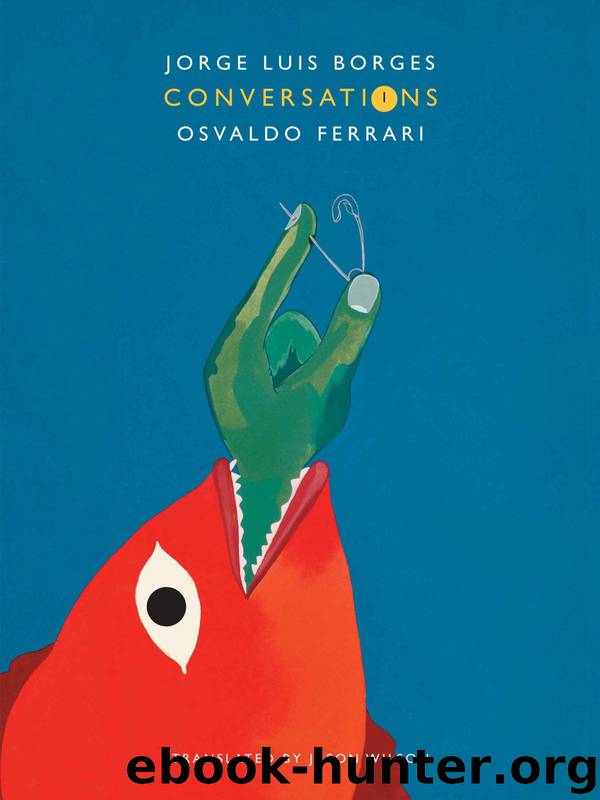Conversations, Volume 1 by Jorge Luis Borges

Author:Jorge Luis Borges
Language: eng
Format: mobi
Tags: Literary Criticism, memoirs, Latin American fiction
ISBN: 9780857421982
Publisher: Seagull Books
Published: 2014-09-14T21:00:00+00:00
.
.
.
.
.
.
.
.
.
.
24
Westerns or Cinema Epics
•
OSVALDO FERRARI. Borges, we have talked about different cultures, literatures and religions. Today, I would like to approach something simpler but just as interesting, something you have cultivated as a spectator and at times an author—your interest in cinema over many years.
JORGE LUIS BORGES. Yes, I think that for obvious commercial reasons, Hollywood saved the epic at a time when the poets had forgotten that poetry began with the epic. Before that cinematography was like a photographed stage. With the arrival of the Westerns, movement was introduced. Horsemen rode from one side to another, shooting pistols. That movement that now seems intrinsic to cinema was created by the Western. I remember that Néstor Ibarra and I recommended that a friend of ours, Julio Medina y Vedia, a very intelligent man, watch a Josef von Sternberg’s film, I can’t recall which. I think it was The Salvation Hunters or perhaps Underwood or The Dragnet. He went to see it but said that he couldn’t follow it because it was made in such an unartistic way. It was so uncomfortable—at times you saw a face from the front, then that face filled the screen; or you saw a character from the back; sometimes there was no character at all, only landscape. Naturally, a film made in such a confused way could be followed by no one. Today, even a child could follow a film. In a sense, I worshipped cinematography, I could have written much on cinema. My cinematographic chronicles have been collected and published in a book, but only what appeared in the magazine Sur which wasn’t much. There were other magazines too, to which I regularly contributed. Also, once you have seen a film, you have the urge to talk about it. In that way, I began . . . well, when I was a child, cinematography had certain conventions that everyone accepted, and once a convention is accepted it ceases being one. For example, if what you were seeing was in sepia you knew it was daytime, but if it was green it was night.
FERRARI. It was a code.
BORGES. Yes, and it was accepted and no one thought of it as artificial. You knew night was green and day was sepia (laughs). And then, as I was telling you, another way developed—a kind of room was photographed, always from the same angle and distance. Later, with Von Sternberg and others like King Vidor or Ernst Lubitsch, one began to photograph the room from different angles. And no one was upset. We accepted it as natural. One of the first films showed an actor attacking, I think, a girl. He had a kind of monkey face. They showed it in a close-up and people went to see that one scene where the huge face of that monstrous man filled the screen. Then the same happened with the talkies. I remember a film with Emil Jannings playing a Russian tsar. He spoke once, asking his assassin to help him.
Download
This site does not store any files on its server. We only index and link to content provided by other sites. Please contact the content providers to delete copyright contents if any and email us, we'll remove relevant links or contents immediately.
| African | Asian |
| Australian & Oceanian | Canadian |
| Caribbean & Latin American | European |
| Jewish | Middle Eastern |
| Russian | United States |
4 3 2 1: A Novel by Paul Auster(11052)
The handmaid's tale by Margaret Atwood(6855)
Giovanni's Room by James Baldwin(5879)
Big Magic: Creative Living Beyond Fear by Elizabeth Gilbert(4723)
Asking the Right Questions: A Guide to Critical Thinking by M. Neil Browne & Stuart M. Keeley(4576)
On Writing A Memoir of the Craft by Stephen King(4214)
Ego Is the Enemy by Ryan Holiday(3991)
Ken Follett - World without end by Ken Follett(3973)
The Body: A Guide for Occupants by Bill Bryson(3802)
Bluets by Maggie Nelson(3711)
Adulting by Kelly Williams Brown(3671)
Guilty Pleasures by Laurell K Hamilton(3587)
Eat That Frog! by Brian Tracy(3514)
White Noise - A Novel by Don DeLillo(3436)
The Poetry of Pablo Neruda by Pablo Neruda(3367)
Alive: The Story of the Andes Survivors by Piers Paul Read(3312)
The Bookshop by Penelope Fitzgerald(3229)
The Book of Joy by Dalai Lama(3218)
Fingerprints of the Gods by Graham Hancock(3214)
